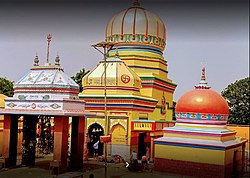Siwan district
This article has multiple issues. Please help improve it or discuss these issues on the talk page. (Learn how and when to remove these template messages)
|
Siwan district | |
|---|---|
 Baba Mahendra Nath Mandir, Mehdar | |
 Location of Siwan district in Bihar | |
| Country | |
| State | Bihar |
| Division | Saran |
| Headquarters | Siwan, Bihar |
| Government | |
| • Lok Sabha constituencies | Siwan |
| • Vidhan Sabha constituencies | Siwan, Ziradei, Darauli, Raghunathpur, Daraunda, Barharia, Goriakothi, Maharajganj |
| Area | |
| • Total | 2,219 km2 (857 sq mi) |
| Population (2011) | |
| • Total | 3,330,465 |
| • Density | 1,500/km2 (3,900/sq mi) |
| Demographics | |
| • Literacy | 71.59 per cent |
| • Sex ratio | 984 |
| Time zone | UTC+05:30 (IST) |
| Major highways | NH 85 |
| Website | siwan |
Siwan district is one of the districts of Bihar state, India. Siwan town is the administrative headquarters of this district. Siwan district is a part of Saran Division since 1972. The district was previously also known as Aliganj Siwan after the name of Raja Ali Bux Khan. Siwan has historical and mythological importance attached to it. Member of Parliament from Siwan is Kavita Singh.[1][2]
The district occupies an area of 2,219 square kilometres (857 sq mi).[3]
History[edit | edit source]
Siwan district, situated in the western part of the state, was originally a sub-division of Saran district, which in ancient times formed a part of Kosala Kingdom.[4] Siwan became a fully-fledged district when it was split from Saran in 1976.[5]
Don, a village in the area, has the ruins of a fort believed to be that of Drona, and contains a stupa that contained the vase of Buddha's ashes. A recently excavated marvelous statue of Lord Vishnu at Bherbania village from underneath a tree indicates that there were large numbers of followers of Lord Vishnu. It is now dominated by Yadavs and Rajputs.[6]
Siwan was a part of Banaras Kingdom during the 8th century. Muslims came here in the 13th century. Sikandar Lodi brought this area under his kingdom in the 15th century. Babar crossed Ghaghra river near Siswan in his return journey. By the end of the 17th century, the Dutch came first; followed by the English. After the battle of Buxar in 1764, it became a part of Bengal.
Siwan played an important role in 1857 independence movement. A good number of them rebelled and rendered their services to Babu Kunwar Singh. The last ruler of Siwan was Raja Ismail Ali Khan. The anti pardah movement in Bihar was started by Sri Braj Kishore Prasad who also belonged to Siwan in response to the Non Co-Operative movement in 1920.[4]
Demographics[edit | edit source]
According to the 2011 census Siwan district has a population of 3,330,464.[7] This gives it a ranking of 101st in India (out of a total of 640).[7] The district has a population density of 1,495 inhabitants per square kilometre (3,870/sq mi) .[7] Its population growth rate over the decade 2001-2011 was 22.25%.[7] Siwan has a sex ratio of 984 females for every 1000 males,[7] and a literacy rate of 71.59%.[7]
At the time of the 2011 Census of India, 93.36% of the population in the district spoke Bhojpuri, 4.30% Urdu and 2.12% Hindi as their first language.[8]
| Year | Pop. | ±% p.a. |
|---|---|---|
| 1901 | 822,808 | — |
| 1911 | 781,902 | −0.51% |
| 1921 | 799,141 | +0.22% |
| 1931 | 849,186 | +0.61% |
| 1941 | 976,835 | +1.41% |
| 1951 | 1,077,453 | +0.99% |
| 1961 | 1,213,268 | +1.19% |
| 1971 | 1,462,067 | +1.88% |
| 1981 | 1,778,930 | +1.98% |
| 1991 | 2,170,971 | +2.01% |
| 2001 | 2,714,349 | +2.26% |
| 2011 | 3,330,464 | +2.07% |
| source:[9] | ||
Notable people[edit | edit source]
- Rajendra Prasad, 1st President of India
- Akhilendra Mishra
- Azazul Haque
- Abdul Ghafoor
- Avishek Sinha
- Apoorvanand
- Baccha Prasad Singh
- Bishwanath Singh
- Brajkishore Prasad
- Chandrashekhar Prasad
- Indradeep Sinha
- Jai Prakash Narayan Singh
- Janardan Tiwari
- Kaushalendra Pratap Shahi
- Kavita Singh
- Khesari Lal Yadav
- Mangal Pandey
- Manoj Bhawuk
- Mihir Diwakar
- Mohammad Shahabuddin
- Natwarlal
- Nirupama Pandey
- Om Prakash Yadav
- Prabhavati Devi
- Ramesh Singh Kushwaha
- Raza Naqvi Wahi
- Syed Ali Akhtar Rizvi
- Satyendra Dubey
- Sunil Prasad
- Shyam Bahadur Singh
- Vashishtha Narayan Singh
- Meeran Haider
References[edit | edit source]
- ↑ Singh, Kavita (2007), "Chapter-24 Antepartum Haemorrhage", Gynecological Cancer, Jaypee Brothers Medical Publishers (P) Ltd., pp. 200–212, doi:10.5005/jp/books/10333_25, ISBN 9788180619090
- ↑ Mehta, Dr. Arun C. "District-specific Literates and Literacy Rates, 2001". Archived from the original on 2010-04-14.
- ↑ Srivastava, Dayawanti et al. (ed.) (2010). "States and Union Territories: Bihar: Government". India 2010: A Reference Annual (54th ed.). New Delhi, India: Additional Director General, Publications Division, Ministry of Information and Broadcasting (India), Government of India. pp. 1118–1119. ISBN 978-81-230-1617-7.
{{cite book}}:|last1=has generic name (help) - ↑ 4.0 4.1 "Archived copy". Archived from the original on 2015-07-17. Retrieved 2015-09-24.
{{cite web}}: CS1 maint: archived copy as title (link) - ↑ Law, Gwillim (2011-09-25). "Districts of India". Statoids. Archived from the original on 2011-10-17. Retrieved 2011-10-11.
- ↑ "This week: Bihar - Indian Express". Archived from the original on 2013-08-13.
- ↑ 7.0 7.1 7.2 7.3 7.4 7.5 "District Census 2011". Census2011.co.in. 2011. Archived from the original on 2011-06-11. Retrieved 2011-09-30.
- ↑ 2011 Census of India, Population By Mother Tongue
- ↑ Decadal Variation In Population Since 1901
External links[edit | edit source]
Template:Blocks of Siwan district Template:Saran Division Template:Districts of Bihar Template:Saran Division topics